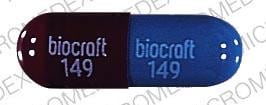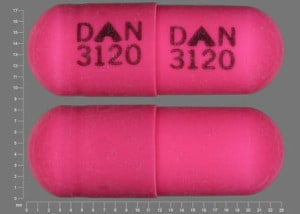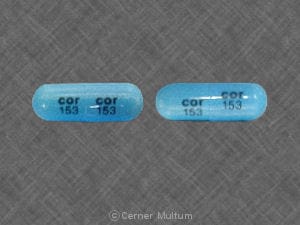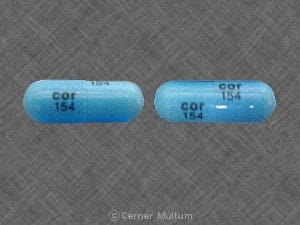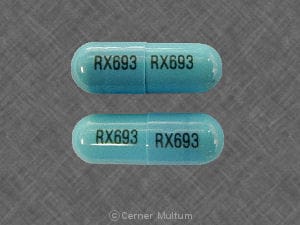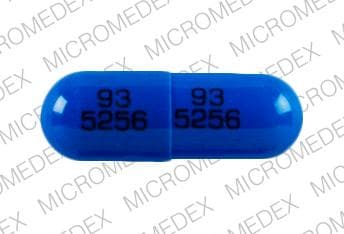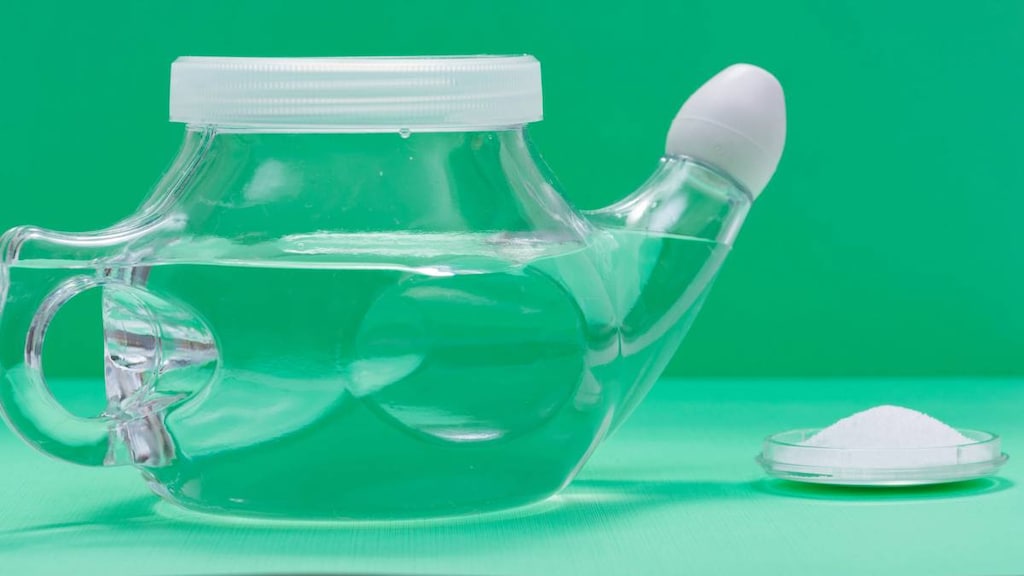Boxed Warning
Colitis:
Clostridioides (formerly Clostridium) difficile-associated diarrhea (CDAD) has been reported with use of nearly all antibacterial agents, including clindamycin, and may range in severity from mild diarrhea to fatal colitis. Treatment with antibacterial agents alters the normal flora of the colon, leading to overgrowth of C. difficile.
Because clindamycin therapy has been associated with severe colitis, which may end fatally, reserve it for serious infections for which less toxic antimicrobial agents are inappropriate. Do not use clindamycin in patients with nonbacterial infections, such as most upper respiratory tract infections.
C. difficile produces toxins A and B, which contribute to the development of CDAD. Hypertoxin-producing strains of C. difficile cause increased morbidity and mortality, as these infections can be refractory to antimicrobial therapy and may require colectomy. CDAD must be considered in all patients who present with diarrhea following antibiotic use. Careful medical history is necessary because CDAD has been reported to occur more than 2 months after the administration of antibacterial agents.
If CDAD is suspected or confirmed, ongoing antibiotic use not directed against C. difficile may need to be discontinued. Institute appropriate fluid and electrolyte management, protein supplementation, antibiotic treatment of C. difficile, and surgical evaluation as clinically indicated.
Dosage Forms
Excipient information presented when available (limited, particularly for generics); consult specific product labeling. [DSC] = Discontinued product
Capsule, Oral, as hydrochloride [strength expressed as base]:
Cleocin: 75 mg, 150 mg [contains brilliant blue fcf (fd&c blue #1), tartrazine (fd&c yellow #5)]
Cleocin: 300 mg [contains brilliant blue fcf (fd&c blue #1)]
Generic: 75 mg, 150 mg, 300 mg
Kit, Injection, as phosphate [strength expressed as base]:
CLIN Single Use: 300 mg/2 mL [DSC] [contains benzyl alcohol, edetate disodium]
Solution, Injection, as phosphate [strength expressed as base]:
Cleocin Phosphate: 300 mg/2 mL (2 mL); 600 mg/4 mL (4 mL); 900 mg/6 mL (6 mL); 9 g/60 mL (60 mL) [contains benzyl alcohol, edetate disodium]
Generic: 300 mg/2 mL (2 mL); 600 mg/4 mL (4 mL); 900 mg/6 mL (6 mL); 9000 mg/60 mL (60 mL); 9 g/60 mL (60 mL)
Solution, Intravenous, as phosphate [strength expressed as base]:
Cleocin in D5W: 600 mg/50 mL (50 mL [DSC]) [contains benzyl alcohol, edetate disodium]
Cleocin Phosphate: 300 mg/2 mL (2 mL); 600 mg/4 mL (4 mL); 900 mg/6 mL (6 mL) [contains benzyl alcohol, edetate disodium]
Generic: 600 mg/50 mL (50 mL); 900 mg/50 mL (50 mL); 300 mg/2 mL (2 mL [DSC]); 600 mg/4 mL (4 mL [DSC]); 900 mg/6 mL (6 mL)
Solution, Intravenous, as phosphate [strength expressed as base, preservative free]:
Cleocin in D5W: 300 mg/50 mL (50 mL [DSC]) [contains benzyl alcohol, edetate disodium]
Cleocin in D5W: 300 mg/50 mL (50 mL [DSC]); 600 mg/50 mL (50 mL [DSC]) [contains edetate disodium]
Cleocin in D5W: 900 mg/50 mL (50 mL [DSC]) [contains benzyl alcohol, edetate disodium]
Cleocin in D5W: 900 mg/50 mL (50 mL [DSC]) [contains edetate disodium]
Generic: 300 mg/50 mL (50 mL); 600 mg/50 mL (50 mL); 900 mg/50 mL (50 mL); 300 mg/50 mL in NaCl 0.9% (50 mL); 600 mg/50 mL in NaCl 0.9% (50 mL); 900 mg/50 mL in NaCl 0.9% (50 mL)
Solution Reconstituted, Oral, as palmitate hydrochloride [strength expressed as base]:
Cleocin: 75 mg/5 mL (100 mL) [contains ethylparaben]
Generic: 75 mg/5 mL (100 mL)
Pharmacology
Mechanism of Action
Reversibly binds to 50S ribosomal subunits preventing peptide bond formation thus inhibiting bacterial protein synthesis; bacteriostatic or bactericidal depending on drug concentration, infection site, and organism
Pharmacokinetics/Pharmacodynamics
Absorption
Oral, hydrochloride: Rapid (90%); clindamycin palmitate must be hydrolyzed in the GI tract before it is active
Distribution
Distributed in body fluids and tissues; no significant levels in CSF, even with inflamed meninges
Metabolism
Biologically inactive clindamycin phosphate (intravenous formulation) is rapidly converted to active clindamycin. Clindamycin is metabolized predominantly by CYP3A4, with minor contribution by CYP3A5, to form clindamycin sulfoxide (major metabolite) and N-desmethylclindamycin (minor metabolite)
Excretion
Urine (~10%) and feces (3.6%) as active drug and metabolites
Time to Peak
Serum: Oral: Within 60 minutes; IM: 1 to 3 hours
Half-Life Elimination
Neonates: Premature: 8.7 hours; Full-term: 3.6 hours; Infants 1 month to 1 year: 3 hours; Children: ~2.5 hours; Adults: 3 hours; Elderly (oral) ~4 hours (range: 3.4 to 5.1 hours)
Protein Binding
94%
Use: Labeled Indications
Bone and joint infections: Treatment of bone and joint infections, including acute hematogenous osteomyelitis caused by Staphylococcus aureus and as adjunctive therapy in the surgical treatment of chronic bone and joint infections caused by susceptible organisms.
Gynecological infections: Treatment of gynecologic infections, including endometritis, nongonococcal tubo-ovarian abscess, pelvic cellulitis, and postsurgical vaginal cuff infection caused by susceptible anaerobes.
Intraabdominal infections: Treatment of intraabdominal infections, including peritonitis and intraabdominal abscess caused by susceptible anaerobic organisms.
Lower respiratory tract infections: Treatment of lower respiratory tract infections, including pneumonia, empyema, and lung abscess caused by susceptible anaerobes, Streptococcus pneumoniae, other streptococci (except Enterococcus faecalis), and S. aureus.
Septicemia: Treatment of septicemia caused by S. aureus, streptococci (except E. faecalis), and susceptible anaerobes.
Skin and skin structure infections: Treatment of skin and skin structure infections caused by Streptococcus pyogenes, S. aureus, and susceptible anaerobes.
Use: Off Label
Anthraxyes
Based on the Centers for Disease Control and Prevention (CDC) expert panel meetings on prevention and treatment of anthrax in adults, clindamycin is an effective and acceptable alternative for postexposure prophylaxis or treatment of cutaneous anthrax; it is also a first-line option, in combination with other antimicrobials, for the treatment of systemic anthrax. Alternative regimens have also been suggested for other patient populations with anthrax, including injectable drug users who develop injectional anthrax Hicks 2012.
Babesiosisyes
Based on the Infectious Diseases Society of America (IDSA) guidelines for the clinical assessment, treatment, and prevention of Lyme disease, human granulocytic anaplasmosis, and babesiosis, clindamycin (in combination with quinine) is an effective and recommended option for the treatment of babesiosis.
Bacterial vaginosisyes
Based on the CDC sexually transmitted diseases treatment guidelines, oral clindamycin is an effective and recommended alternative agent for patients with bacterial vaginosis.
Bite wound, prophylaxis or treatment, animal or human biteyes
Based on the IDSA guidelines for the diagnosis and management of skin and soft tissue infections, clindamycin, in combination with a second- or third-generation cephalosporin, levofloxacin, or sulfamethoxazole and trimethoprim, is an effective and recommended alternative for treatment of animal or human bite wounds.
Diabetic foot infection, mild to moderateyes
Based on the IDSA guidelines for the diagnosis and treatment of diabetic foot infections, clindamycin is an effective and recommended alternative treatment option for mild diabetic foot infection due to S. aureus or Streptococcus spp and, in combination with ciprofloxacin or levofloxacin, for moderate diabetic foot infection
Endocarditis, prophylaxis (dental or invasive respiratory tract procedures) (alternative agent for penicillin-allergic patients)yes
Based on the American Heart Association (AHA) guidelines for the prevention of infective endocarditis, clindamycin is an effective and recommended alternative agent for the prevention of infective endocarditis associated with dental or respiratory tract procedures in patients with certain cardiac conditions who are allergic to penicillins or ampicillin.
Group B streptococci, maternal prophylaxis for prevention of neonatal diseaseyes
Based on the American College of Obstetricians and Gynecologists (ACOG) Prevention of Group B Streptococcal Early-Onset Disease in Newborns guideline, the use of intravenous clindamycin is effective and recommended in patients at high risk for anaphylaxis due to penicillin allergy if the GBS isolate is sensitive to clindamycin.
Hidradenitis suppurativacyes
Data from a prospective, observational cohort study and a retrospective cohort study suggest that clindamycin, in combination with rifampin, may be beneficial for the treatment of hidradenitis suppurativa Dessinioti 2016, Gener 2009. Based on the European S1 guideline on hidradenitis suppurativa/acne inversa, clindamycin, in combination with rifampin, is an effective and recommended agent for the treatment of hidradenitis suppurativa.
Malariayes
Based on the CDC guidelines for the treatment of malaria, clindamycin, in combination with quinidine or quinine, is effective and recommended for the treatment of malaria.
Neutropenic fever, empiric therapy for low-risk cancer patients (alternative agent for penicillin-allergic patients)byes
Data from a prospective, randomized, open-label study support the use of clindamycin (in combination with ciprofloxacin) for the outpatient management of neutropenic fever in low-risk cancer patients Rubenstein 1993. Based on the IDSA guidelines for the use of antimicrobial agents in neutropenic patients with cancer and the American Society of Clinical Oncology (ASCO) and IDSA guidelines for the outpatient management of fever and neutropenia in adults treated for malignancy, clindamycin (in combination with ciprofloxacin) is an effective and recommended agent for the management of neutropenic fever in low-risk cancer patients.
Odontogenic infectionb
Data from two randomized, prospective, blinded (one single-blind, one double-blind) studies support the use of clindamycin for the treatment of odontogenic infections Cachovan 2011, Tancawan 2015.
Pneumocystis jirovecii pneumonia, treatmentyes
Based on the US Department of Health and Human Services (HHS) guidelines for the prevention and treatment of opportunistic infections in HIV-infected adults and adolescents, clindamycin (with primaquine) is an effective and recommended alternative regimen for the treatment of Pneumocystis jirovecii pneumonia in HIV-infected adolescents and adults.
Pneumonia due to methicillin-resistant Staphylococcus aureusyes
Based on the IDSA guidelines for the treatment of methicillin-resistant S. aureus infections in adults, clindamycin is effective and recommended in the treatment of community-acquired methicillin-resistant S. aureus pneumonia.
Prosthetic joint infectioncyes
Based on the IDSA guidelines for the management of prosthetic joint infection, clindamycin is an effective and recommended alternative agent for the treatment of prosthetic joint infection due to Cutibacterium acnes.
Clinical experience suggests the utility of clindamycin as chronic suppressive treatment of prosthetic joint infection caused by methicillin-resistant staphylococci Berbari 2019.
Rhinosinusitis, acute bacterialcyes
Based on the IDSA guidelines for acute bacterial rhinosinusitis (ABRS) in children and adults, clindamycin (in combination with cefixime or cefpodoxime) is an effective and recommended therapy for the treatment of ABRS.
Clinical experience suggests the utility of clindamycin (in combination with cefixime or cefpodoxime) for the treatment of ABRS Patel 2018.
Streptococcal (group A) pharyngitis and chronic carriageyes
Based on the IDSA guidelines for the diagnosis and management of group A streptococcal pharyngitis, clindamycin is an effective and recommended alternative agent for the treatment of streptococcal pharyngitis and an option for treatment of chronic group A streptococcal carriage.
Surgical prophylaxisyes
Based on the American Society of Health-System Pharmacists (ASHP) clinical practice guidelines for antimicrobial prophylaxis in surgery, clindamycin, given as an alternative antibiotic in patients with beta-lactam allergy requiring surgical prophylaxis, is effective and recommended for a number of surgical procedures.
Toxoplasma gondii encephalitis and pneumonitis (treatment/long-term maintenance)yes
Based on the US Department of Health and Human Services guidelines for the prevention and treatment of opportunistic infections in HIV-infected adults and adolescents and the American Society of Transplantation Infectious Diseases Community of Practice guidelines on parasitic infections in solid organ transplantation, clindamycin (with pyrimethamine and leucovorin) is an effective and recommended alternative regimen for the treatment and long-term maintenance therapy of Toxoplasma gondii encephalitis and pneumonitis.
Contraindications
Hypersensitivity to clindamycin, lincomycin, or any component of the formulation.
Canadian labeling: Additional contraindications (not in US labeling): Oral clindamycin: Infants <30 days of age.
Dosage and Administration
Dosing: Adult
Usual dose:
Oral: 600 to 1,800 mg/day in 2 to 4 divided doses; up to 2,400 mg/day in 4 divided doses may be given for severe infections.
IM, IV: 600 to 2,700 mg/day in 2 to 4 divided doses; according to the manufacturer, up to 4,800 mg/day IV (in divided doses) has been used in life-threatening infections; however, data supporting this dose are lacking; maximum: 600 mg/dose IM.
Anthrax (off-label use): Note: Consult public health officials for event-specific recommendations.
Inhalational exposure postexposure prophylaxis (alternative agent): Oral: 600 mg every 8 hours for 60 days. Note: Anthrax vaccine should also be administered to exposed individuals (CDC [Hendricks 2014]).
Cutaneous, without systemic involvement, empiric therapy (alternative agent): Oral: 600 mg every 8 hours for 60 days following biological weapon-related event; duration is 7 to 10 days after naturally acquired infection. Note: Patients with cutaneous lesions of the head or neck or extensive edema should be treated for systemic involvement (CDC [Hendricks 2014]).
Systemic, meningitis excluded: IV: 900 mg every 8 hours in combination with other appropriate agents for at least 2 weeks or until clinically stable, whichever is longer (CDC [Hendricks 2014]).
Meningitis (alternative agent): IV: 900 mg every 8 hours in combination with other appropriate agents for at least 2 to 3 weeks or until clinically stable, whichever is longer (CDC [Hendricks 2014]).
Note: Antitoxin should also be administered for systemic anthrax. Following the course of IV combination therapy for systemic anthrax infection (including meningitis), patients exposed to aerosolized spores require oral monotherapy to complete a total antimicrobial course of 60 days (CDC [Hendricks 2014]).
Babesiosis (off-label use):
Mild to moderate disease: Oral: 600 mg every 8 hours in combination with quinine for 7 to 10 days (IDSA [Wormser 2006]).
Severe disease: IV: 600 mg every 6 hours for 7 to 10 days in combination with quinine (IDSA [Wormser 2006]; Krause 2019); a longer duration is needed for those at high risk for relapse (Krause 2008; Sanchez 2016; Vannier 2012). Clindamycin can be given orally once symptoms have abated and parasitemia is reduced (Krause 2019; Sanchez 2016).
Bacterial vaginosis (alternative agent) (off-label use): Oral: 300 mg twice daily for 7 days (CDC [Workowski 2015])
Bite wound, prophylaxis or treatment, animal or human bite (alternative agent) (off-label use): Note: For animal bite, use in combination with an appropriate agent for Pasteurella multocida. For human bite, use in combination with an appropriate agent for Eikenella corrodens (IDSA [Stevens 2014]).
Oral: 300 to 450 mg 3 times daily (Baddour 2019a; Baddour 2019b; IDSA [Stevens 2014]).
IV: 600 mg every 6 to 8 hours (IDSA [Stevens 2014]). Note: In selected patients with high-risk wounds, some experts recommend parenteral therapy be given initially until infection is resolving, followed by oral therapy (Baddour 2019a; Baddour 2019b).
Note: For prophylaxis, duration is 3 to 5 days (IDSA [Stevens 2014]); for treatment of established infection, duration is typically 5 to 14 days and varies based on patient-specific factors, including clinical response (Baddour 2019a; Baddour 2019b).
Diabetic foot infection, mild to moderate (alternative agent) (off-label use): Oral: 300 to 450 mg every 6 to 8 hours (Bader 2008; IDSA [Lipsky 2012]; Lipsky 1990; Weintrob 2018). Note: May be used alone for empiric therapy of mild infections; if there are risk factors for gram-negative bacilli, must be used in combination with other appropriate agents. Duration of therapy should be tailored to individual clinical circumstances; most patients respond to 1 to 2 weeks of therapy (IDSA [Lipsky 2012]; Weintrob 2018).
Endocarditis, prophylaxis (dental or invasive respiratory tract procedures) (alternative agent for penicillin-allergic patients) (off-label use):
Oral: 600 mg as a single dose 30 to 60 minutes prior to procedure (AHA [Wilson 2007]).
IM, IV: 600 mg as a single dose 30 to 60 minutes before procedure (only if unable to tolerate or absorb oral therapy) (AHA [Wilson 2007]).
Note: Only recommended for patients with cardiac conditions associated with the highest risk of an adverse outcome from endocarditis and who are undergoing a procedure likely to result in bacteremia with an organism that has the potential ability to cause endocarditis (AHA [Wilson 2007]).
Hidradenitis suppurativa (off-label use): Oral: 300 mg twice daily in combination with rifampin for 10 to 12 weeks (Dessinioti 2016; Gener 2009; Gulliver 2016; Zouboulis 2015).
Malaria (off-label use):
Uncomplicated malaria, treatment, chloroquine-resistant or unknown resistance (alternative agent): Oral: 20 mg/kg/day in divided doses every 8 hours for 7 days in combination with quinine sulfate. Note: Quinine sulfate duration is region specific (CDC 2013).
Severe malaria, treatment: IV: Loading dose: 10 mg/kg followed by 5 mg/kg every 8 hours in combination with IV quinidine gluconate; may switch to oral therapy (clindamycin plus quinine sulfate) when tolerated. Note: Duration of clindamycin is 7 days. Quinine sulfate duration is region specific (CDC 2013).
Neutropenic fever, empiric therapy for low-risk cancer patients (alternative agent for penicillin-allergic patients) (off-label use): Oral: 600 mg every 8 hours (Rubenstein 1993); some experts recommend 300 mg every 6 hours (Bow 2018) (data on appropriate dose are limited). Use in combination with oral ciprofloxacin; continue until afebrile and neutropenia has resolved. Note: Avoid in patients who have received fluoroquinolone prophylaxis. Administer first dose in the health care setting (after blood cultures are drawn); observe patient for ≥4 hours before discharge (ASCO/IDSA [Taplitz 2018]; IDSA [Freifeld 2011]).
Odontogenic infection (alternative agent for penicillin-allergic patients) (off-label use):
IV: 600 mg every 8 hours until improved, then transition to oral clindamycin (Bhagania 2018; Chow 2018).
Oral (initial therapy for mild infection or step-down after parenteral treatment): 450 mg every 8 hours to complete a 7- to 14-day course (Chow 2018); doses in the literature varied from 150 mg every 6 hours (Tancawan 2015) to 300 mg every 6 hours (Cachovan 2011) to 600 mg every 8 hours (Bhagania 2018).
Osteomyelitis:
Osteomyelitis due to MRSA (alternative agent): IV, Oral: 600 mg 3 times daily for a minimum of 8 weeks; some experts combine with rifampin (IDSA [Liu 2011]).
Osteomyelitis, native vertebral due to staphylococci, methicillin-susceptible (alternative agent):
IV: 600 to 900 mg every 8 hours for 6 weeks (IDSA [Berbari 2015]).
Oral: 300 to 450 mg 4 times daily (IDSA [Berbari 2015]) or 600 mg 3 times daily (IDSA [Liu 2011]) for 6 weeks (IDSA [Berbari 2015]). Note: Clindamycin may also be used as suppressive therapy in selected patients (Osmon 2019).
Osteomyelitis, native vertebral due to Cutibacterium acnes (alternative agent): IV: 600 to 900 mg every 8 hours for 6 weeks (IDSA [Berbari 2015]).
Pelvic inflammatory disease, severe: IV: 900 mg every 8 hours with gentamicin; after 24 to 48 hours of sustained clinical improvement, transition to clindamycin 450 mg orally 4 times daily (or oral doxycycline) to complete 14 days of therapy. Note: If tubo-ovarian abscess is present, oral clindamycin should be given in combination with doxycycline to complete at least 14 days of therapy rather than giving doxycycline alone (CDC [Workowski 2015]).
Pneumocystis jirovecii pneumonia (PCP), treatment (alternative agent) (off-label use):
Mild to moderate disease: Oral: 450 mg every 6 hours or 600 mg every 8 hours with primaquine for 21 days (HHS [OI adult 2017]).
Severe disease: IV: 600 mg every 6 hours or 900 mg every 8 hours with primaquine for 21 days; following clinical improvement, clindamycin can be given orally at 450 mg every 6 hours or 600 mg every 8 hours (HHS [OI adult 2017]; Thomas 2018).
Note: Patients with moderate or severe infection (PaO2 <70 mm Hg at room air or alveolar-arterial oxygen gradient ≥35 mm Hg) should receive adjunctive glucocorticoids (HHS [OI adult 2017]).
Pneumonia due to MRSA (alternative agent) (off-label use): Oral, IV: 600 mg 3 times daily; duration is for a minimum of 7 days and varies based on disease severity and response to therapy (IDSA [Liu 2011])
Postpartum endometritis: IV: 900 mg every 8 hours plus gentamicin; treat until the patient is clinically improved (no fundal tenderness) and afebrile for 24 to 48 hours (Chen 2018; Gall 1996).
Prosthetic joint infection (off-label use):
Cutibacterium acnes, treatment (alternative agent for penicillin allergy):
IV: 600 to 900 mg every 8 hours for 4 to 6 weeks (IDSA [Osmon 2013]).
Oral: 300 to 450 mg every 6 hours (IDSA [Osmon 2013]), following at least 2 weeks of parenteral therapy (Kanafani 2018).
Methicillin-resistant staphylococci, treatment (chronic suppression): Oral: 600 mg every 8 hours (Berbari 2019).
Rhinosinusitis, acute bacterial (alternative agent for penicillin-allergic patients able to tolerate cephalosporins with concern for pneumococcal resistance) (off-label use): Oral: 300 mg every 6 to 8 hours in combination with a third-generation cephalosporin (eg, cefixime or cefpodoxime) for 5 to 7 days (IDSA [Chow 2012]; Patel 2018; Rosenfeld 2016). Note: In uncomplicated acute bacterial rhinosinusitis, initial observation and symptom management without antibiotic therapy is appropriate in most patients (AAO-HNS [Rosenfeld 2015]; Harris 2016).
Septic arthritis due to Staphylococcus aureus (including MRSA) (alternative agent): Oral, IV: 600 mg 3 times daily for 3 to 4 weeks (Goldenberg 2018; IDSA [Liu 2011]). Note: A longer course of parenteral therapy (4 weeks) may be required for patients with concomitant bacteremia (in the absence of endocarditis) (Goldenberg 2019).
Skin and soft tissue infections:
Impetigo or ecthyma if MRSA is suspected or confirmed (alternative agent): Oral: 300 to 450 mg 4 times daily for 7 days (IDSA [Stevens 2014).
Nonpurulent cellulitis or erysipelas due to beta-hemolytic streptococci or Staphylococcus aureus (including MRSA), empiric or pathogen-directed therapy (alternative agent):
Oral: 300 to 450 mg 4 times daily.
IV: 600 mg to 900 mg every 8 hours.
Note: Transition to oral therapy once improving; treat for at least 5 days but may extend to 14 days depending on severity and clinical response (IDSA [Stevens 2014]; Spelman 2019).
Purulent cellulitis or abscess due to Staphylococcus aureus (including MRSA) or beta-hemolytic streptococci (alternative agent):
Oral: 300 to 450 mg 4 times daily. Treat for 5 to 14 days depending on severity and clinical response.
Note: Systemic antibiotics only indicated for certain instances (eg, immunocompromised patients, signs of systemic infection, large or multiple abscess, indwelling device, high risk for adverse outcome with endocarditis). If at risk for gram-negative bacilli, use in combination with an appropriate agent (IDSA [Stevens 2014]; Spelman 2019).
Necrotizing soft tissue infections (alternative agent): IV: 600 to 900 mg every 8 hours as part of an appropriate combination regimen. Note: Antibiotic therapy must be used in conjunction with early and aggressive surgical exploration and debridement of necrotic tissue (IDSA [Stevens 2014]; Stevens 2018a).
Streptococcus (group A):
Bloodstream infection: IV: 900 mg every 8 hours in combination with IV penicillin G; duration is individualized, but clindamycin may be discontinued within 48 hours for patients without septic shock, organ failure, or necrotizing infection. Continue penicillin G to complete ≥14 days of therapy (Stevens 2019b).
Pharyngitis (alternative agent for penicillin-allergic patients) (off-label use): Oral: 300 mg 3 times daily for 10 days (IDSA [Shulman 2012]).
Chronic carriage (off-label use): Oral: 300 mg 3 times daily for 10 days. Note: Most individuals with chronic carriage do not require antimicrobial treatment (IDSA [Shulman 2012]).
Streptococcus (group B), maternal prophylaxis for prevention of neonatal disease (alternative agent) (off-label use):
Note: Prophylaxis is reserved for pregnant women with a positive group B streptococci (GBS) vaginal or rectal screening in late gestation or GBS bacteriuria during the current pregnancy, history of birth of an infant with early-onset GBS disease, and unknown GBS culture status with any of the following: birth <37 0/7 weeks gestation, intrapartum fever, prolonged rupture of membranes, known GBS positive in a previous pregnancy, or intrapartum nucleic acid amplification testing positive for GBS (ACOG 2019).
IV: 900 mg at onset of labor or prelabor rupture of membranes, then every 8 hours until delivery. Note: Clindamycin should be reserved for penicillin-allergic patients at high risk for anaphylaxis (ACOG 2019).
Surgical prophylaxis (in combination with other appropriate agents when coverage for MRSA is indicated or for gram-positive coverage in patients unable to tolerate cephalosporins) (off-label use): IV: 900 mg started within 60 minutes prior to initial surgical incision. Clindamycin doses may be repeated intraoperatively at 6-hour intervals if procedure is lengthy or if there is excessive blood loss (ASHP/IDSA/SIS/SHEA [Bratzler 2013]). In cases where an extension of prophylaxis is warranted postoperatively, total duration should be ≤24 hours (Anderson 2014; ASHP/IDSA/SIS/SHEA [Bratzler 2013]). For clean and clean-contaminated procedures, continued prophylactic antibiotics beyond surgical incision closure is not recommended, even in the presence of a drain (CDC [Berríos-Torres 2017]).
Toxic shock syndrome (empiric therapy): IV: 900 mg every 8 hours as part of an appropriate combination regimen (Lappin 2009; Wong 2013). Duration of therapy varies based on causative organism and response to therapy; treat patients who are bacteremic for at least 14 days (Stevens 2019b).
Toxoplasma gondii encephalitis and pneumonitis (alternative agent) (off-label use):
Initial treatment: Oral, IV: 600 mg every 6 hours in combination with pyrimethamine and leucovorin. Continue therapy for at least 6 weeks; longer duration may be required if incomplete response or extensive disease; after completion of acute therapy, all patients should receive long-term maintenance therapy (HHS [OI adult 2017]; Schwartz 2013).
Long-term maintenance therapy: Oral: 600 mg every 8 hours in combination with pyrimethamine and leucovorin (HHS [OI adult 2017]; Schwartz 2013); in HIV-infected patients, may discontinue when asymptomatic with a CD4 count >200 cells/mm3 and an undetectable HIV viral load for >6 months in response to ART (HHS [OI adult 2017]).
Dosing: Geriatric
Refer to adult dosing.
Dosing: Pediatric
General dosing, susceptible infection:
IM, IV:
Manufacturer's labeling: Infants, Children, and Adolescents 1 month to 16 years:
Weight-directed dosing: 20 to 40 mg/kg/day divided every 6 to 8 hours.
BSA-directed dosing: 350 to 450 mg/m2/day divided every 6 to 8 hours.
Alternate dosing (Red Book [AAP] 2012): Infants, Children, and Adolescents:
Mild to moderate infections: 20 mg/kg/day divided every 8 hours; maximum daily dose: 1,800 mg/day.
Severe infections: 40 mg/kg/day divided every 6 to 8 hours; maximum daily dose: 2,700 mg/day.
Oral:
Manufacturer's labeling: Infants, Children, and Adolescents:
Hydrochloride salt (capsule): 8 to 20 mg/kg/day divided every 6 to 8 hours.
Palmitate salt (solution): 8 to 25 mg/kg/day divided every 6 to 8 hours; minimum dose: 37.5 mg 3 times daily.
Alternate dosing (Red Book [AAP]; 2012): Infants, Children, and Adolescents:
Mild to moderate infections: 10 to 25 mg/kg/day divided every 8 hours; maximum daily dose: 1,800 mg/day.
Severe infections: 30 to 40 mg/kg/day divided every 6 to 8 hours; maximum daily dose: 1,800 mg/day.
Babesiosis: Infants, Children, and Adolescents: Oral: 20 to 40 mg/kg/day divided every 8 hours for 7 to 10 days plus quinine; maximum single dose: 600 mg (Red Book [AAP] 2012).
Bacterial endocarditis prophylaxis for dental and upper respiratory procedures in penicillin-allergic patients (Red Book [AAP] 2012; Wilson 2007): Infants, Children, and Adolescents:
IM, IV: 20 mg/kg 30 minutes before procedure; maximum single dose: 600 mg.
Oral: 20 mg/kg 1 hour before procedure; maximum single dose: 600 mg.
Note: American Heart Association (AHA) guidelines now recommend prophylaxis only in patients undergoing invasive procedures and in whom underlying cardiac conditions may predispose to a higher risk of adverse outcomes should infection occur. As of April 2007, routine prophylaxis for GI/GU procedures is no longer recommended by the AHA.
Catheter (peritoneal dialysis); exit-site or tunnel infection: Infant, Children, and Adolescents: Oral: 10 mg/kg/dose 3 times daily; maximum dose: 600 mg/dose (Warady [ISPD 2012]).
Intra-abdominal infection, complicated: Infants, Children, and Adolescents: IV: Note: Not recommended for community-acquired infections due to increasing Bacteroides fragilis resistance: 20 to 40 mg/kg/day divided every 6 to 8 hours in combination with gentamicin or tobramycin (Solomkin 2010).
Malaria, treatment: Infants, Children, and Adolescents:
Uncomplicated: Oral: 20 mg/kg/day divided every 8 hours for 7 days plus quinine (CDC 2011; Red Book [AAP] 2012).
Severe: IV: Loading dose: 10 mg/kg once followed by 15 mg/kg/day divided every 8 hours plus IV quinidine gluconate; switch to oral therapy (clindamycin and quinine, see above) when able for total treatment duration of 7 days. Note: Quinine duration is region specific; consult CDC for current recommendations (CDC 2011).
Osteomyelitis, septic arthritis, due to MRSA: Infants, Children, and Adolescents: IV, Oral: 40 mg/kg/day divided every 6 to 8 hours for at least 4 to 6 weeks (osteomyelitis) or 3 to 4 weeks (septic arthritis) (IDSA [Liu 2011]).
Otitis media, acute: Infants ≥6 months, Children, and Adolescents: Oral: 30 to 40 mg/kg/day divided every 8 hours; administer with or without a third generation cephalosporin (AAP [Lieberthal 2013]).
Peritonitis (peritoneal dialysis):
Prophylaxis (Warady [ISPD 2012]):
Invasive dental procedures: Oral: 20 mg/kg administered 30 to 60 minutes before procedure; maximum dose: 600 mg.
Gastrointestinal or genitourinary procedures: IV: 10 mg/kg administered 30 to 60 minutes before procedure; maximum dose: 600 mg.
Treatment: Intraperitoneal, continuous: Loading dose: 300 mg per liter of dialysate; maintenance dose: 150 mg per liter; Note: 125 mg/liter has also been recommended as a maintenance dose (Aronoff 2007; Warady [ISPD 2012]).
Pharyngitis:
AHA guidelines (Gerber 2009): Children and Adolescents: Oral: 20 mg/kg/day in divided doses 3 times daily for 10 days; maximum single dose: 600 mg.
IDSA guidelines (Shulman, 2012): Children and Adolescents: Oral:
Treatment and primary prevention of rheumatic fever: 21 mg/kg/day in divided doses 3 times daily for 10 days; maximum single dose: 300 mg.
Treatment of chronic carriers: 20 to 30 mg/kg/day in divided doses 3 times daily for 10 days; maximum single dose: 300 mg.
Pneumococcal disease, invasive: Infants, Children, and Adolescents: IV: 25 to 40 mg/kg/day divided every 6 to 8 hours (Red Book [AAP] 2012).
Pneumocystis jirovecii (formerly carnii) pneumonia (PCP):
Non HIV-exposed/-positive (Red Book [AAP] 2012): Infants, Children, and Adolescents:
Mild to moderate disease: Oral: 10 mg/kg 3 to 4 times daily for 21 days; in combination with other agents; maximum single dose: 450 mg.
Moderate to severe disease: IV: 15 to 25 mg/kg 3 to 4 times daily for 21 days; give with pentamidine or primaquine; maximum single dose: 600 mg. May switch to oral dose after clinical improvement.
HIV-exposed/-positive: Adolescents (DHHS [adult] 2013):
Mild to moderate disease: Oral: 300 mg every 6 hours or 450 mg every 8 hours with primaquine for 21 days.
Moderate to severe disease:
Oral: 300 mg every 6 hours or 450 mg every 8 hours with primaquine for 21 days.
IV: 600 mg every 6 hours or 900 mg every 8 hours with primaquine for 21 days.
Pneumonia:
Community-acquired pneumonia (CAP) (IDSA/PIDS [Bradley 2011]): Infants ≥3 months, Children, and Adolescents: Note: In children ≥5 years, a macrolide antibiotic should be added if atypical pneumonia cannot be ruled out.
Moderate to severe infection: IV: 40 mg/kg/day divided every 6 to 8 hours.
Mild infection, step-down therapy: Oral: 30 to 40 mg/kg/day divided every 6 to 8 hours.
MRSA pneumonia: IV: 40 mg/kg/day divided every 6 to 8 hours for 7 to 21 days (IDSA [Liu 2011]).
Rhinosinusitis, acute bacterial: Children and Adolescents: Oral: 30 to 40 mg/kg/day divided every 8 hours with concomitant cefixime or cefpodoxime for 10 to 14 days. Note: Recommended in patients with nontype I penicillin allergy, after failure to initial therapy, or in patients at risk for antibiotic resistance (eg, daycare attendance, age <2 years, recent hospitalization, antibiotic use within the past month) (Chow 2012).
Skin and soft tissue infection: Infants, Children, and Adolescents:
Impetigo: Oral: 20 mg/kg/day in divided doses 3 times daily for 7 days; maximum dose: 400 mg/dose (IDSA [Stevens 2014]).
MRSA infection: Note: Treatment duration based on clinical response, usually 7 to 14 days for complicated skin and soft tissue infection and 5 to 10 days for outpatient cellulitis (nonpurulent or purulent) (IDSA [Liu 2011]).
IV: 25 to 40 mg/kg/day in divided doses 3 times daily (IDSA [Stevens 2014]) or 40 mg/kg/day in divided doses every 6 to 8 hours (IDSA [Liu 2011]); maximum dose: 600 mg/dose.
Oral: 30 to 40 mg/kg/day in divided doses 3 times daily (IDSA [Stevens 2014]) or 30 to 40 mg/kg/day in divided doses every 6 to 8 hours (IDSA [Liu 2011]); maximum dose: 450 mg/dose.
MSSA infection (IDSA [Stevens 2014]): Duration of treatment dependent upon site and severity of infection; cellulitis and abscesses that have been drained typically require 5 to 10 days of therapy.
IV: 25 to 40 mg/kg/day in divided doses 3 times daily; maximum dose: 600 mg/dose.
Oral: 25 to 30 mg/kg/day in divided doses 3 times daily; maximum dose: 450 mg/dose.
Necrotizing infections: IV: 10 to 13 mg/kg/dose every 8 hours; maximum dose: 900 mg/dose; may use in combination with other antibiotics based on organism. Continue until further debridement is not necessary, patient has clinically improved, and patient is afebrile for 48 to 72 hours (IDSA [Stevens 2014]).
Surgical prophylaxis: Children and Adolescents: IV: 10 mg/kg 30 to 60 minutes prior to the procedure; may repeat in 6 hours; maximum single dose: 900 mg (Bratzler 2013).
Toxoplasmosis (HIV-exposed/positive or hematopoietic cell transplantation recipients):
Infants and Children (CDC 2009; Red Book [AAP] 2012; Tomblyn 2009):
Treatment, HIV-exposed/-positive: IV, Oral: 5 to 7.5 mg/kg/dose 4 times daily with pyrimethamine and leucovorin; maximum single dose: 600 mg.
Secondary prevention:
HIV-exposed/-positive: Oral: 7 to 10 mg/kg/dose every 8 hours and pyrimethamine plus leucovorin; maximum single dose: 600 mg (DHHS [pediatric] 2013).
Hematopoietic cell transplantation recipients: Oral: 5 to 7.5 mg/kg/dose every 6 hours and pyrimethamine plus leucovorin; maximum single dose: 450 mg.
Adolescents (DHHS [adult] 2013; Red Book [AAP] 2012; Tomblyn 2009):
Treatment: Oral, IV: 600 mg every 6 hours with pyrimethamine and leucovorin for at least 6 weeks; longer if clinical or radiologic disease is extensive or response is incomplete.
Secondary prevention:
HIV-exposed/-positive: Oral: 600 mg every 8 hours with pyrimethamine and leucovorin.
Hematopoietic cell transplantation recipients: Oral: 300 to 450 mg every 6 to 8 hours with pyrimethamine and leucovorin.
Reconstitution
Injection: Never administer undiluted as bolus. For IV infusion, dilute vials with 50 to 100 mL of compatible diluent (eg, D5W, NS); concentration of clindamycin for IV infusion should not exceed 18 mg/mL.
Oral solution: Reconstitute bottles of 100 mL with 75 mL of water. Add a large portion of the water and shake vigorously; add the remainder of the water and shake until the solution is uniform. When reconstituted with water, each 5 mL of solution contains clindamycin palmitate hydrochloride equivalent to clindamycin 75 mg.
Administration
IM: Deep IM sites, rotate sites; do not exceed 600 mg in a single injection.
IV: Never administer undiluted as bolus; administer by IV intermittent infusion over at least 10 to 60 minutes, at a maximum rate of 30 mg/minute (do not exceed 1,200 mg/hour).
Oral: Capsule should be taken with a full glass of water to avoid esophageal irritation; shake oral solution well before use; may administer with or without meals.
Storage
Oral: Store at 20°C to 25°C (68°F to 77°F). Do not refrigerate the reconstituted oral solution (it will thicken); the solution is stable for 2 weeks at room temperature.
IV: Store intact vials and premixed bags at 20°C to 25°C (68°F to 77°F). Infusion solution in NS or D5W solution is stable for 16 days at room temperature, 32 days refrigerated, or 8 weeks frozen. After initial use, discard any unused portion of vial after 24 hours.
Clindamycin (Systemic) Images
Drug Interactions
BCG (Intravesical): Antibiotics may diminish the therapeutic effect of BCG (Intravesical). Avoid combination
BCG Vaccine (Immunization): Antibiotics may diminish the therapeutic effect of BCG Vaccine (Immunization). Monitor therapy
Cholera Vaccine: Antibiotics may diminish the therapeutic effect of Cholera Vaccine. Management: Avoid cholera vaccine in patients receiving systemic antibiotics, and within 14 days following the use of oral or parenteral antibiotics. Avoid combination
CYP3A4 Inducers (Strong): May decrease the serum concentration of Clindamycin (Systemic). Refer to the specific clindamycin (systemic) - rifampin drug interaction monograph for information concerning that combination. Exceptions: RifAMPin. Monitor therapy
Kaolin: May decrease the absorption of Lincosamide Antibiotics. Monitor therapy
Lactobacillus and Estriol: Antibiotics may diminish the therapeutic effect of Lactobacillus and Estriol. Monitor therapy
Mecamylamine: Lincosamide Antibiotics may enhance the neuromuscular-blocking effect of Mecamylamine. Avoid combination
Neuromuscular-Blocking Agents: Lincosamide Antibiotics may enhance the neuromuscular-blocking effect of Neuromuscular-Blocking Agents. Monitor therapy
Sodium Picosulfate: Antibiotics may diminish the therapeutic effect of Sodium Picosulfate. Management: Consider using an alternative product for bowel cleansing prior to a colonoscopy in patients who have recently used or are concurrently using an antibiotic. Consider therapy modification
Typhoid Vaccine: Antibiotics may diminish the therapeutic effect of Typhoid Vaccine. Only the live attenuated Ty21a strain is affected. Management: Vaccination with live attenuated typhoid vaccine (Ty21a) should be avoided in patients being treated with systemic antibacterial agents. Use of this vaccine should be postponed until at least 3 days after cessation of antibacterial agents. Consider therapy modification
Adverse Reactions
Frequency not defined.
Cardiovascular: Hypotension (rare; IV administration), thrombophlebitis (IV)
Central nervous system: Metallic taste (IV)
Dermatologic: Acute generalized exanthematous pustulosis, erythema multiforme (rare), exfoliative dermatitis (rare), maculopapular rash, pruritus, skin rash, Stevens-Johnson syndrome (rare), toxic epidermal necrolysis, urticaria, vesiculobullous dermatitis
Gastrointestinal: Abdominal pain, antibiotic-associated colitis, Clostridioides (formerly Clostridium) difficile-associated diarrhea, diarrhea, esophageal ulcer, esophagitis, nausea, pseudomembranous colitis, unpleasant taste (IV), vomiting
Genitourinary: Azotemia, oliguria, proteinuria, vaginitis
Hematologic & oncologic: Agranulocytosis, eosinophilia (transient), neutropenia (transient), thrombocytopenia
Hepatic: Abnormal hepatic function tests, jaundice
Hypersensitivity: Anaphylactic shock, anaphylactoid reaction (rare), anaphylaxis, angioedema, hypersensitivity reaction
Immunologic: DRESS syndrome
Local: Abscess at injection site (IM), induration at injection site (IM), irritation at injection site (IM), pain at injection site (IM)
Neuromuscular & skeletal: Polyarthritis (rare)
Renal: Renal insufficiency (rare)
Warnings/Precautions
Concerns related to adverse effects:
- Colitis: [US Boxed Warning]: Can cause severe and possibly fatal colitis. Should be reserved for serious infections where less toxic antimicrobial agents are inappropriate. It should not be used in patients with nonbacterial infections such as most upper respiratory tract infections. Hypertoxin-producing strains of C. difficile cause increased morbidity and mortality, as these infections can be refractory to antimicrobial therapy and may require colectomy. C. difficile-associated diarrhea (CDAD) must be considered in all patients who present with diarrhea following antibiotic use. CDAD has been observed >2 months postantibiotic treatment. If CDAD is suspected or confirmed, ongoing antibiotic use not directed against C. difficile may need to be discontinued. Institute appropriate fluid and electrolyte management, protein supplementation, antibiotic treatment of C. difficile, and surgical evaluation as clinically indicated.
- Hypersensitivity: Severe hypersensitivity reactions, including severe skin reactions (eg, drug reaction with eosinophilia and systemic symptoms [DRESS], Stevens-Johnson syndrome [SJS], toxic epidermal necrolysis [TEN]), some fatal, and anaphylactic reactions, including anaphylactic shock, have been reported. Permanently discontinue treatment and institute appropriate therapy if these reactions occur.
- Superinfection: Use may result in overgrowth of nonsusceptible organisms, particularly yeast. Should superinfection occur, appropriate measures should be taken as indicated by the clinical situation.
Disease-related concerns:
- GI disease: Use with caution in patients with a history of GI disease, particularly colitis.
- Hepatic impairment: Use with caution in patients with moderate to severe liver disease, however, when administered at every-8-hour intervals, drug accumulation is rare. Monitor hepatic enzymes periodically as dosage adjustments may be necessary in patients with severe liver disease.
Concurrent drug therapy issues:
- Drug-drug interactions: Potentially significant interactions may exist, requiring dose or frequency adjustment, additional monitoring, and/or selection of alternative therapy. Consult drug interactions database for more detailed information.
Special populations:
- Atopic patients: Use with caution in atopic patients.
- Elderly: A subgroup of older patients with associated severe illness may tolerate diarrhea less well. Monitor carefully for changes in bowel frequency.
Dosage form specific issues:
- Benzyl alcohol and derivatives: Some dosage forms may contain benzyl alcohol; large amounts of benzyl alcohol (≥99 mg/kg/day) have been associated with a potentially fatal toxicity (“gasping syndrome”) in neonates; the “gasping syndrome” consists of metabolic acidosis, respiratory distress, gasping respirations, CNS dysfunction (including convulsions, intracranial hemorrhage), hypotension and cardiovascular collapse (AAP ["Inactive" 1997]; CDC 1982); some data suggests that benzoate displaces bilirubin from protein binding sites (Ahlfors 2001); avoid or use dosage forms containing benzyl alcohol with caution in neonates. See manufacturer’s labeling.
- Tartrazine: Some products may contain tartrazine (FD&C yellow no. 5), which may cause allergic reactions in certain individuals. Allergy is frequently seen in patients who also have an aspirin hypersensitivity.
Other warnings/precautions:
- Administration (IV): Do not inject IV undiluted as a bolus. Product should be diluted in compatible fluid and infused over 10 to 60 minutes.
- Appropriate use: Not appropriate for use in the treatment of meningitis due to inadequate penetration into the CSF.
Monitoring Parameters
Observe for changes in bowel frequency. Monitor for colitis and resolution of symptoms. In severe liver disease monitor liver function tests periodically; during prolonged therapy monitor CBC, liver and renal function tests periodically.
Pregnancy
Pregnancy Considerations
Clindamycin crosses the placenta and can be detected in the cord blood and fetal tissue (Philipson 1973; Weinstein 1976). Clindamycin injection contains benzyl alcohol which may also cross the placenta.
Clindamycin pharmacokinetics are not affected by pregnancy (Philipson 1976; Weinstein 1976).
Clindamycin is recommended for use in pregnant women for the prophylaxis of group B streptococcal disease in newborns (alternative therapy) (ACOG 782 2019); prophylaxis and treatment of Toxoplasma gondii encephalitis (alternative therapy), or Pneumocystis pneumonia (PCP) (alternative therapy) (HHS [OI adult ] 2019); bacterial vaginosis (CDC [Workowski 2015]); anthrax (Meaney-Delman 2014); or malaria (CDC 2019). Clindamycin is also one of the antibiotics recommended for prophylactic use prior to cesarean delivery and may be used in certain situations prior to vaginal delivery in women at high risk for endocarditis (ACOG 199 2018).
Patient Education
What is this drug used for?
- It is used to treat or prevent bacterial infections.
Frequently reported side effects of this drug
- Abdominal pain
- Nausea
- Vomiting
- Bad taste
- Diarrhea
Other side effects of this drug: Talk with your doctor right away if you have any of these signs of:
- Clostridioides (formerly Clostridium) difficile (C. diff)-associated diarrhea like abdominal pain or cramps, severe diarrhea or watery stools, or bloody stools
- Injection site pain, edema, or redness
- Joint pain
- Joint swelling
- Unable to pass urine
- Change in amount of urine passed
- Yellow skin
- Swollen glands
- Vaginal pain, itching, and discharge
- Stevens-Johnson syndrome/toxic epidermal necrolysis like red, swollen, blistered, or peeling skin (with or without fever); red or irritated eyes; or sores in mouth, throat, nose, or eyes
- Signs of a significant reaction like wheezing; chest tightness; fever; itching; bad cough; blue skin color; seizures; or swelling of face, lips, tongue, or throat
Note: This is not a comprehensive list of all side effects. Talk to your doctor if you have questions.
Consumer Information Use and Disclaimer: This information should not be used to decide whether or not to take this medicine or any other medicine. Only the healthcare provider has the knowledge and training to decide which medicines are right for a specific patient. This information does not endorse any medicine as safe, effective, or approved for treating any patient or health condition. This is only a brief summary of general information about this medicine. It does NOT include all information about the possible uses, directions, warnings, precautions, interactions, adverse effects, or risks that may apply to this medicine. This information is not specific medical advice and does not replace information you receive from the healthcare provider. You must talk with the healthcare provider for complete information about the risks and benefits of using this medicine.
